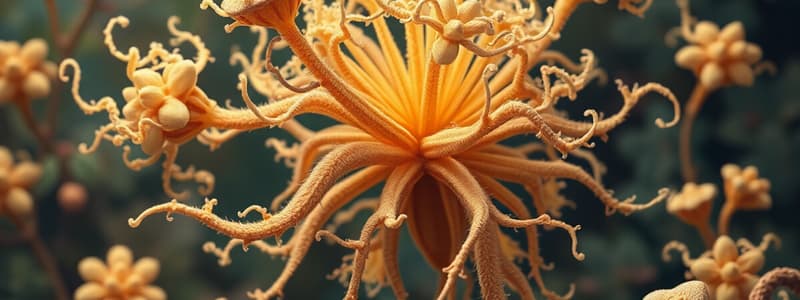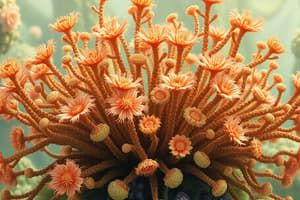Podcast
Questions and Answers
What defines a protist?
What defines a protist?
- It exclusively contains prokaryotic cells.
- It is always autotrophic.
- It is a multicellular organism.
- It is any organism that is not a plant, animal, or fungus. (correct)
Which of the following is true about the majority of protists?
Which of the following is true about the majority of protists?
- They all belong to the same class.
- They can only be heterotrophic.
- They are mostly unicellular, with some being multicellular. (correct)
- They primarily live in dry environments.
What method do zooflagellates use to move?
What method do zooflagellates use to move?
- Cilia
- One or two flagella (correct)
- Pseudopodia
- They do not move
Which characteristic is associated with ciliates?
Which characteristic is associated with ciliates?
How do sarcodines, like amoeba, primarily move?
How do sarcodines, like amoeba, primarily move?
What is the primary function of the nucleus in an amoeba?
What is the primary function of the nucleus in an amoeba?
What is the process by which amoebas reproduce?
What is the process by which amoebas reproduce?
Why do amoebas form cysts?
Why do amoebas form cysts?
How do contractile vacuoles contribute to the amoeba's survival?
How do contractile vacuoles contribute to the amoeba's survival?
What disease is commonly caused by amoebas?
What disease is commonly caused by amoebas?
What role do pseudopods play in amoeba behavior?
What role do pseudopods play in amoeba behavior?
In which environments are amoebas likely to create cysts?
In which environments are amoebas likely to create cysts?
What would most likely happen if an amoeba did not have a contractile vacuole?
What would most likely happen if an amoeba did not have a contractile vacuole?
How do paramecium primarily move?
How do paramecium primarily move?
What distinguishes the feeding method of amoeba from that of paramecium?
What distinguishes the feeding method of amoeba from that of paramecium?
Which cell structure is responsible for controlling the movement of substances in and out of the protist cell?
Which cell structure is responsible for controlling the movement of substances in and out of the protist cell?
What function do cilia serve in the human body compared to their function in paramecium?
What function do cilia serve in the human body compared to their function in paramecium?
What is the primary method of digestion in paramecium?
What is the primary method of digestion in paramecium?
What is a defining feature of pathogenic protozoans like those causing amebic dysentery?
What is a defining feature of pathogenic protozoans like those causing amebic dysentery?
What role do mitochondria play in protists?
What role do mitochondria play in protists?
Which of the following structures is NOT typically used for locomotion in protists?
Which of the following structures is NOT typically used for locomotion in protists?
What is the process called when one organism lives inside another and benefits from that arrangement?
What is the process called when one organism lives inside another and benefits from that arrangement?
Which cell structure is primarily associated with energy production in eukaryotic cells?
Which cell structure is primarily associated with energy production in eukaryotic cells?
What type of cellular division do prokaryotes, such as bacteria, use?
What type of cellular division do prokaryotes, such as bacteria, use?
In a life cycle, what do gametophytes primarily produce?
In a life cycle, what do gametophytes primarily produce?
Which term describes a cell that contains two complete sets of chromosomes?
Which term describes a cell that contains two complete sets of chromosomes?
What is the primary benefit for an ancestral prokaryote in a symbiotic relationship?
What is the primary benefit for an ancestral prokaryote in a symbiotic relationship?
What structure is formed as a result of the fertilization process in the life cycle of algae?
What structure is formed as a result of the fertilization process in the life cycle of algae?
In terms of evolutionary biology, how do chloroplasts contribute to their host cell?
In terms of evolutionary biology, how do chloroplasts contribute to their host cell?
What term refers to the fingerlike extensions that amoebas use to move and consume food?
What term refers to the fingerlike extensions that amoebas use to move and consume food?
What is the primary function of the amoeba's cell membrane?
What is the primary function of the amoeba's cell membrane?
What are the two types of cytoplasm found in an amoeba?
What are the two types of cytoplasm found in an amoeba?
What process do amoebas use to engulf food particles?
What process do amoebas use to engulf food particles?
What is the function of lysosomes in an amoeba?
What is the function of lysosomes in an amoeba?
How do amoebas primarily obtain their nutrients?
How do amoebas primarily obtain their nutrients?
Where can amoebas typically be found?
Where can amoebas typically be found?
What color is the ectoplasm when labeled in a diagram?
What color is the ectoplasm when labeled in a diagram?
What process do most plant-like protists use to create their own food?
What process do most plant-like protists use to create their own food?
Which of the following is a characteristic of Euglenophytes?
Which of the following is a characteristic of Euglenophytes?
Which of the following groups make up the base of aquatic food chains?
Which of the following groups make up the base of aquatic food chains?
What unique feature do diatoms possess?
What unique feature do diatoms possess?
Which group of unicellular algae is known for causing red tides?
Which group of unicellular algae is known for causing red tides?
What role do accessory pigments play in plant-like protists?
What role do accessory pigments play in plant-like protists?
Phytoplankton are responsible for what proportion of the photosynthesis occurring on Earth?
Phytoplankton are responsible for what proportion of the photosynthesis occurring on Earth?
Which of the following statements is true regarding chrysophytes?
Which of the following statements is true regarding chrysophytes?
What characteristic distinguishes dinoflagellates from other unicellular algae?
What characteristic distinguishes dinoflagellates from other unicellular algae?
Which of the following organisms primarily engages in photosynthesis in clear water environments?
Which of the following organisms primarily engages in photosynthesis in clear water environments?
Flashcards
Kingdom Protista
Kingdom Protista
A kingdom of mostly unicellular eukaryotic organisms that do not fit into the other kingdoms (plants, animals, or fungi).
Eukaryotic organisms
Eukaryotic organisms
Organisms whose cells contain a nucleus and other membrane-bound organelles.
Unicellular organisms
Unicellular organisms
Organisms composed of only one cell.
Heterotrophic protists
Heterotrophic protists
Signup and view all the flashcards
Zooflagellates
Zooflagellates
Signup and view all the flashcards
Cilia
Cilia
Signup and view all the flashcards
Pseudopods
Pseudopods
Signup and view all the flashcards
Pseudopodia
Pseudopodia
Signup and view all the flashcards
Amoeba movement
Amoeba movement
Signup and view all the flashcards
Sporozoans
Sporozoans
Signup and view all the flashcards
Phagocytosis
Phagocytosis
Signup and view all the flashcards
Food vacuole
Food vacuole
Signup and view all the flashcards
Cell membrane (in Amoeba)
Cell membrane (in Amoeba)
Signup and view all the flashcards
Anal pore
Anal pore
Signup and view all the flashcards
Amoeba Reproduction
Amoeba Reproduction
Signup and view all the flashcards
Protist
Protist
Signup and view all the flashcards
Lysosome
Lysosome
Signup and view all the flashcards
Contractile Vacuole
Contractile Vacuole
Signup and view all the flashcards
Amoeba Cyst
Amoeba Cyst
Signup and view all the flashcards
Amebic Dysentery
Amebic Dysentery
Signup and view all the flashcards
Binary Fission
Binary Fission
Signup and view all the flashcards
Pseudopod Function
Pseudopod Function
Signup and view all the flashcards
Amoeba Name Origin
Amoeba Name Origin
Signup and view all the flashcards
Amoeba Eating Mechanism
Amoeba Eating Mechanism
Signup and view all the flashcards
Paramecium Movement
Paramecium Movement
Signup and view all the flashcards
Amoeba Movement
Amoeba Movement
Signup and view all the flashcards
Paramecium Feeding
Paramecium Feeding
Signup and view all the flashcards
Amoeba Feeding
Amoeba Feeding
Signup and view all the flashcards
Cilia Function (humans)
Cilia Function (humans)
Signup and view all the flashcards
Contractile vacuole
Contractile vacuole
Signup and view all the flashcards
Pathogenic Protozoan
Pathogenic Protozoan
Signup and view all the flashcards
Malaria Vector
Malaria Vector
Signup and view all the flashcards
Endosymbiosis
Endosymbiosis
Signup and view all the flashcards
Chloroplast
Chloroplast
Signup and view all the flashcards
Mitochondria
Mitochondria
Signup and view all the flashcards
Binary Fission
Binary Fission
Signup and view all the flashcards
Prokaryotic Cell
Prokaryotic Cell
Signup and view all the flashcards
Eukaryotic Cell
Eukaryotic Cell
Signup and view all the flashcards
Sporophyte
Sporophyte
Signup and view all the flashcards
Gametophyte
Gametophyte
Signup and view all the flashcards
Phytoplankton role
Phytoplankton role
Signup and view all the flashcards
Protists' photosynthesis
Protists' photosynthesis
Signup and view all the flashcards
accessory pigments
accessory pigments
Signup and view all the flashcards
Euglenophytes
Euglenophytes
Signup and view all the flashcards
Chrysophytes
Chrysophytes
Signup and view all the flashcards
Diatoms
Diatoms
Signup and view all the flashcards
Dinoflagellates
Dinoflagellates
Signup and view all the flashcards
Photosynthesis in protists
Photosynthesis in protists
Signup and view all the flashcards
Aquatic food chain base
Aquatic food chain base
Signup and view all the flashcards
Protist adaptation
Protist adaptation
Signup and view all the flashcards
Study Notes
Kingdom Protista
- Protists are a diverse group of organisms
- They do not fit into the other kingdoms
- Mostly unicellular, some are multicellular
- Can be autotrophic or heterotrophic
- Most live in moist soil or even the human body
- Protists are eukaryotic
Classification of Protists
- How they obtain nutrition
- How they move
Main Types of Protists
- Animal-like Protists (Protozoa):
- Heterotrophic
- Amoeba, Paramecium, Giardia lamblia, etc.
- Plant-like Protists (Algae):
- Autotrophic
- Euglena, Diatoms, etc.
- Fungus-like Protists (Heterotrophs):
- Decomposers.
Prokaryotic vs. Eukaryotic Cells
- Prokaryotic cells are smaller
- Prokaryotic cells lack a nucleus
- Prokayrotic cells lack membrane bound organelles
- Eukaryotic cells are larger
- Eukaryotic cells have a nucleus
- Eukaryotic cells contain membrane bound organelles
Animal-like Protists - Specifics
- Zooflagellates (e.g., Giardia lamblia) move using flagella, absorb food across membrane
- Sarcodinas (e.g., Amoeba) use pseudopodia (false feet) for movement and engulfing food (phagocytosis), forming a food vacuole
- Ciliates (e.g., Paramecium) move using cilia, have a macronucleus and a micronucleus, food gathered through a mouth pore
- Sporozoans (e.g., Malaria) do not move on their own, parasitic
Amoeba - Animal-like Protist
- Protozoan that belongs to the Kingdom Protista
- Moves using pseudopodia
- Engulfs food by phagocytosis
- Contains cytoplasm (ectoplasm and endoplasm)
- Has a nucleus and lysosomes
- Reproduces through binary fission
- Forms a cyst during unfavorable conditions
Pathogenic Protozoans
- Beaver Fever, Paralytic Shellfish Poisoning, Amebic Dysentery
Questions for Thought
- What is a vector?
- Why is controlling a vector important?
- How was malaria controlled historically?
- What effect did this have on the environment?
Plant-like Protists - Specifics
-
Mostly contain chlorophyll and accessory pigments
-
Make up the base of aquatic food chains
-
Four phyla: Euglenophytes, Chrysophytes, Diatoms, Dinoflagellates
-
Euglenophytes have flagella, chloroplasts, and can be heterotrophs in the dark
-
Chrysophytes have golden-colored chloroplasts, store food as starch
-
Diatoms have cell walls made of glass
-
Pyrophyta have flagella, can emit light
Cellular Structures in Protists
- Cell membrane: controls materials moving in and out of the cell
- Cilia: used for movement
- Flagella: used for movement
- Mitochondria: site of cellular respiration
- Ribosomes: protein synthesis
- Contractile vacuole: removes excess water
- Pseudopods: used for movement and feeding
- Gullet(pore)/ food vacuole: used to channel food
- Nucleus: contains the genetic material of the organism
- Chloroplasts: used for photosynthesis
Studying That Suits You
Use AI to generate personalized quizzes and flashcards to suit your learning preferences.




